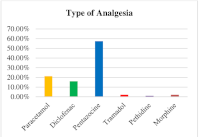Analgesic use in the intensive care unit of a tertiary teaching hospital
Main Article Content
Abstract
Background: Moderate to severe pain is common in the intensive care unit (ICU). There are various sources of pain in the ICU ranging from trauma-related pain, acute post-operative pain, ICU procedure-related pains and pain from disease processes. We aim to determine the pattern of analgesic use and the extent of use of potent opioids in our ICU.
Methodology: This was a retrospective audit of all ICU admissions during 12 months in a tertiary hospital in Northern Nigeria after an ethical waiver. Data on age, sex, indication for admission (medical/surgical) and types of analgesics were retrieved and analyzed using SPSS version 21. Continuous data were summarized as mean±standard deviations while qualitative data were summarized as proportions. Fisher’s Exact Test (FET) was computed. The level of significance was set at p≤0.05.
Results: There were 98 admissions out of whom 94(95.9%) received analgesics. Females that were administered analgesics constituted 42(44.7%) of admitted patients. The mean age was 35.4±18.4years. Most of the admissions were surgical 86(91.5%). Paracetamol, diclofenac, pentazocine and tramadol were used in 20(21.3%), 15(16%), 54(57.4%), and 2(2.1%) patients while pethidine and morphine were administered in 1(1.1%) and 2(2.1%) patients respectively. There was no statistically significant relationship between the types of analgesics used and indication for admission (medical/surgical) p=0.422 (FET).
Conclusion: Most of those treated during the period under review were postoperative surgical patients. Pentazocine was the most commonly used analgesic at that time and there was low utilization of potent opioids such as fentanyl and morphine.
Downloads
Article Details
Issue
Section

This work is licensed under a Creative Commons Attribution-NonCommercial-ShareAlike 4.0 International License.
How to Cite
References
1. Stanik-Hutt JA, Soeken KL, Belcher AE, Fontaine DK, Gift AG. Pain experiences of traumatically injured patients in a critical care setting. Am J Crit Care. 2001; 10(4):252-9.
2. Desbiens NA, Wu AW. Pain and suffering in seriously ill hospitalized patients. J Am Geriatr Soc 2000; 48(Suppl 5):S183–6.
3. Practice guidelines for acute pain management in the perioperative setting: an updated report by the American Society of Anesthesiologists Task Force on Acute Pain Management. Anesthesiology. 2012; 116(2):248-73.
4. Sakata RK. Analgesia and Sedation in Intensive Care Unit. Rev Bras Anestesiol 2010; 60(6): 648-658.
5. Riker RR, Fraser GL – Altering intensive care sedation paradigms to improve patient outcomes. Crit Care Clin, 2009; 25:527-538.
6. Payen JF, Chanques G, Mantz J, Hercule C, Auriant I, Leguillou JL, et al. Current practices in sedation and analgesia for mechanically ventilated critically ill patients: a prospective multicenter patient-based study. Anesthesiology 2007; 106: 687–95.
7. Barr J, Fraser GL, Puntillo K, Ely EW, Gelinas C, Dasta JF, et al. Clinical practice guidelines for the management of pain, agitation, and delirium in adult patients in the intensive care unit. Crit Care Med 2013; 41: 263–306.
8. Narayanan M, Venkataraju A. Analgesia in intensive care: part 1.BJA Education 2016; 16(2): 72-78.
9. Payen J, Bru O, Bosson JL, Lagrasta A, Novel E, Deschaux I, et al. Assessing pain in critically ill sedated patients by using a behavioural pain scale. Crit Care Med 2001; 29: 2258–63.
10. King CD, Goodin B, Glover TL, Riley JL, Hou W, Staud R, Fillingim RB: Is the pain-reducing effect of opioid medication reliable? A psychophysical study of morphine and Pentazocine analgesia. Pain 2013; 154(3):476–83.
11. Tade AO, Salami BA, Ayoade AB. Pentazocine Pain Relief in Adult Patients with Acute Abdominal Pain. A Prospective Randomized Clinical Trial. East Cent. Afr. J Surg. 2009; 14(2): 44-49.
12. Makanjuola AB, Olatunji PO. Pentazocine abuse in sickle cell anemia patients. A report of two cases vignettes. Afr J Drug Alcohol Stud 2009; 8(2):59-64.
13. Reid MC, Henderson CR, Papaleontiou M, Amanfo L, Olkhovskaya Y, Moore AA, et al. Characteristics of older adults receiving opioids in primary care: treatment duration and outcomes. Pain Med 2010; 11(7): 1063-1071.
14. Trescot AM, Helm S, Hansen H, Benyamin R, Glaser SE, Adlaka R, et al. Opioids in the management of chronic non-cancer pain: an update of American Society of the Interventional Pain Physicians' (ASIPP) Guidelines. Pain Physician 2008; 11(2):5-62.
15. Iheanacho OE, Ezenwenyi IP, Enosolease ME. Pentazocine abuse in Sickle Cell Disease Patients seen at a tertiary hospital in Nigeria: a chronic menace. Int J Trop Dis Health 2015; 9(10): 1-8.
16. Madu AJ, Korubo K, Okoye H, Ugwu N, Efobi C, Nwogoh B, et al. Survey of pentazocine addiction and opioid use in adult sickle cell anaemia patients: The perspective of healthcare providers. Haematol Int J 2018; 2:000133.
17. Ehikhamenor EE, Aghahowa SE, Azodo CC. Retrospective evaluation of analgesics prescribing pattern in a tertiary hospital in Nigeria. JMBR 2012; 11(1):71-77.
18. Bannwarth B, Pehourcq F: Pharmacological rationale for the clinical use of paracetamol: pharmakinetic and pharmadynamic issues. Drugs 2003; 63: 2-5.
19. Day RO, Graham GG, Whelton A: The position of paracetamol in the world of analgesics. Am J Ther 2000; 7:51-54.
20. Dashputra AV, Badwaik RT. Utilization of analgesics in perioperative cases of teaching hospital. Int J Med Pharm Sci 2013; 3(6):14-19.
21. Kumarasingam T, Revathy S, Mukherjee. Drug utilization pattern of analgesics among postoperative patients in a tertiary care hospital. Der Pharmacia Lettre 2014; 6(3)40-46.
22. Imranuddin M, Lakshmi BV, Kameswari G. Prescribing patterns of analgesics in a tertiary care teaching hospital in Rangareddy Dist Telangana. IAJPS 2016; 3(8): 804-808.
23. Macintyre PE, Schug SA, Scott DA. Acute pain management: the evidence grows. MJA 2006; 184 (3):101-102.
24. Sinatra RS, Jahr JS, Reynolds LW, Viscusi ER, Groudine SB, Payen-Champenois C. Efficacy and safety of single and repeated administration of 1 gram intravenous acetaminophen injection (paracetamol) for pain management after major orthopedic surgery. Anesthesiology. 2005; 102(4):822-31.
25. Ali A. Chohan U, Atiq F. Intravwnous tramadol vs ketorolac in laparoscopic dye test. J Coll Physicians Surg Pak. 2006; 16(1):3-6.


